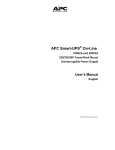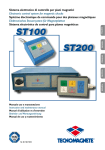Download APC Switch English/need fix
Transcript
Thank You! Thank you for selecting the APC KVM Switch. The APC KVM Switch has been designed for many years of reliable, maintenence free service. APC is dedicated to the development of high-performance electrical power conversion and control products and we hope that you will find this product a valuable, convenient addition to your computing system. Please read this manual! It provides important safety, installation and operating instructions that will help you get the most from your switch. Save this manual! It includes instructions for obtaining factory service should the proper operation of the APC KVM Switch come into question. Radio Frequency Interference WARNING: Changes or modifications to this unit not expressly approved by the party responsible for compliance could void the user’s authority to operate this equipment. FCC Statement NOTE: This equipment has been tested and found to comply with the limits for a Class A digital device, pursuant to Part 15 of the FCC Rules. These limits are designed to provide reasonable protection against harmful interference when the equipment is operated in a commercial environment. This equipment generates, uses and can radiate radio frequency energy and, if not installed and used in accordance with the instruction manual, may cause harmful interference to radio communications. Operation of this equipment in a residential area is likely to cause harmful interference in which case the user will be required to correct the interference at his own expense. Canadian Department of Communications Statement This digital apparatus does not exceed the Class A limits for radio noise emissions from digital apparatus set out in the Radio Interference Regulations of the Canadian Department of Communications. Le présent appareil numérique n’émet pas de bruits radioélectriques dépassant les limites applicables aux appareils numériques de la classe A prescrites dans le Règlement sur le brouillage radioélectrique édicté par le Ministère des Communications du Canada . Table of Contents Chapter 1 - Product Overview Feature Overview .......................................................................................................... 1 Compatibility .................................................................................................................... 3 Chapter 2 - Installation Basic Installation ............................................................................................................. 4 Rack Mount Installation .............................................................................................. 6 Advanced Installation .................................................................................................. 7 Chapter 3 - Basic Operations Overview ........................................................................................................................... 8 Keyboard Control .......................................................................................................... 9 Keyboard Switching ..................................................................................................... 10 System Control & Maintenance .............................................................................. 11 Chapter 4 - OSD Operations Activating OSD ............................................................................................................... 12 The OSD Window ......................................................................................................... 13 The Command Menu .................................................................................................. 14 Basic Channel Maintenance .................................................................................... 15 The ID Window .............................................................................................................. 17 Administrator Functions ............................................................................................ 19 Chapter 5 - Channel Scanning Choosing a Scanning Method ................................................................................ 22 Setting the Scanning Order ..................................................................................... 23 Turning Scanning On and Off ................................................................................ 23 Setting the Scanning Dwell Time .......................................................................... 24 Scanning and Security ................................................................................................ 25 Chapter 6 - Appendices Specifications ................................................................................................................... 26 Pairing ................................................................................................................................. 27 Troubleshooting ............................................................................................................ 33 Problem Report ............................................................................................................... 38 Entire contents copyright 1998 American Power Conversion. All rights reserved; reproduction in whole or in part without permission is prohibited. INSTRUCTIONS: The exclamation point within an equilateral triangle is intended to alert the user to the presence of important operating and maintenance (servicing) instructions in the literature accompanying the appliance. DANGEROUS VOLTAGE: The lightning flash with arrowhead symbol, within an equilateral triangle, is intended to alert the user to the presence of uninsulated “dangerous voltage” within the product's enclosure that may be of sufficient magnitude to constitute a risk of electric shock to persons. PROTECTIVE GROUNDING TERMINAL: A terminal which must be connected to earth ground prior to making any other connections to the equipment. POWER ON: This symbol indicates the principle on/off switch is in the on position. POWER OFF: This symbol indicates the principle on/off switch is in the off position. 1.1 Product Overview - Feature Overview The APC KVM Switch allows you to control up to 64 computers with one keyboard, monitor and mouse. Each computer can be up to 25 feet away from the switch. The switch works with IBM PC/AT and PS/2 systems, and 100% compatible machines with support for VGA, SVGA, XGA and XGA-II video. PS/2 keyboard and PS/2 mouse peripherals are supported through the rear of the unit. Expansion for up to 64 computers An APC KVM Switch unit will support from one to eight attached computers, or channels. If more than eight channels are needed, multiple units can be cascaded together for expansion. Up to 2 tiers of units can be connected for a total of 64 attached computers in one system. On-screen display capability Configure and control your APC KVM Switch with on-screen menuing. Name your computer channels anything you wish, then select the desired computer from an easy-to-use menu. Secondary menus let you configure and initiate channel scanning and other system features. Advanced security for total control over system access Use the advanced bi-level security feature to configure and control server access for every type of user in the system. The administrator has full access privileges; individual users can have viewing or viewing/ editing capability for each attached server. IntelliMouse support The APC KVM Switch offers full support for the Microsoft IntelliMouse. OSD Configuration Utility The OSD Configuration Utility allows the administrator to easily configure and download a channel list with defined users and access privileges to the entire system. This utility will also read and save your current configuration for extra security. 1 Push-button and keyboard switching In addition to using the on-screen menus, you can switch computer channels in one of three easy ways: via the APC KVM Switch channel push-buttons, with the Scan button or with a simple keyboard sequence. “Keep Alive” feature APC KVM Switch’s “Keep Alive” feature allows attached servers to power the unit in the event of a switch power failure. This prevents attached computers from locking up and keeps you from losing time and data. Built-in scanning capabilities A built-in scanning feature allows you to automatically monitor, or scan, your computers without intervention. When keyboard activity is detected, scanning is suspended until all activity stops. Scanning then resumes with the next channel in sequence. Status indicator LEDs Indicator LEDs give you constant readings on the status of your APC KVM Switch unit. Status, scanning and channel LEDs take the guesswork out of system operation and diagnostics. A typical APC KVM Switch configuration is shown below. S STATU 8 7 6 5 4 3 2 1 SCAN 2 1.2 Compatibility The APC KVM Switch requires a PS/2 mouse and keyboard. The following mice are known to be compatible: IBM PS/2-style Kensington Logitech Mouseman (PS/2) Logitech Trackman Microsoft Serial-PS/2 mouse Microsoft IntelliMouse Other manufacturers' mice may operate with the APC KVM Switch. If you experience problems using an untested mouse, contact APC Technical Support with the manufacturer and model number of the mouse in question. 3 2.1 Installation - Basic Installation 1. Power down all computers that will be part of your APC KVM Switch system. Connecting your Peripherals 2. Locate your PS/2 keyboard, VGA video monitor and PS/2 mouse. 3. Plug your VGA monitor cable into the port on the back of your APC KVM Switch. Plug your PS/2 keyboard cable and your PS/2 mouse cable into the ports labeled and respectively. A E ER US NG RI I PA VGA MONITOR CABLE PS/2 MOUSE CABLE PS/2 KEYBOARD CABLE 4 Connecting Computers to the APC KVM Switch 4. Locate your first input cable. It will have a 25-pin “D” connector at one end. Plug this cable into any numbered channel port on the rear of the switch. The other end of the input cable will have three connectors: a 15-pin “HDD” connector for your video, a PS/2 keyboard connection, and a PS/2 mouse connection. The PS/2 connectors are designated by a mouse or keyboard icon on the connector. Plug these connectors into the matching ports on your computer. MOUSE PORT KEYBOARD PORT VIDEO PORT T 2A, .1a , 50/ 80H z POWER 100 -24 0V ~, 250 VA C PAT US EN T ER PE ND ING H G F E D C B A MA DE IN US A 5. Locate your next input cable. Repeat step 4 until all computers are properly attached to the switch. 6. Locate the power cord that came with your APC KVM Switch unit. Plug it into the IEC power connector on the switch. Make sure that the power switch is off, then plug the other end of the power cord into an APC UPS or appropriate AC wall outlet. This outlet must be near the equipment and easily accessible to allow for unplugging prior to any servicing of the unit. 5 1 ! 0 z 0H /6 A, 50 , .1 0V 24 00 1 7. Power-up your APC KVM Switch unit first, then all attached servers. The APC KVM Switch and all attached servers should be powered-down before servicing the unit. Always disconnect the power cord from the wall outlet. 2.2 Rack Mount Installation 1. Remove the side screws that secure the cover on your KVM Switch. 2. Line up the holes in the side brackets with the screw holes in the side of the KVM Switch unit. 3. Using the previously removed screws, thread one through each of the holes in the sides of the rack mount brackets and into the KVM Switch cover. Tighten them securely. .1a , 50 /80 Hz T 2A , 25 0 VA C POWER 10 0-24 0V ~, PA IR IN G US ER 8 7 6 5 4 3 2 1 MA DE IN US A 6 2.3 Advanced Installation Attaching Multiple APC KVM Switch Units 1. Follow steps 1-6 of the Basic Installation section. 2. Plug the 25-pin “D” connector of your input cable into any available channel port on the rear of your base switch unit. MADE IN USA 3. Plug the 15-pin video connector on the other end of the cable into on your first cascading KVM switch unit. Plug the port labeled the PS/2 mouse connector, designated by a mouse icon, into the port. Plug the remaining 6-pin miniDIN keyboard connector into port. the PS/2 MOUSE CONNECTOR CASCADING UNIT H C MADE IN USA D BASE UNIT D G B H C F A G VGA VIDEO CONNECTOR B E ER US F A E G IN IR ER US PA 1 ! PATENT PENDING 0 G IN /60 A, IR Hz 50 PA 1 , .1 0V 24 0- ! 10 PATENT PENDING 0 /60 , , .1A Hz 50 0V 24 0- 10 PS/2 KEYBOARD CONNECTOR 4. Repeat steps 2-3 for every cascaded switch unit in your system. 5. Power-up your switch unit(s) first, then all attached computers. 7 3.1 Basic Operations - Overview Your APC KVM Switch may be operated in a non secure (no password required) or secure (password required) mode. All units ship defaulted to the non-secure mode. For information on implementing password security see the “Administrator Functions” section of Chapter 4. Computers may be powered-up one-at-a-time or all at once. No operator intervention is required during booting. As the system stabilizes, an amber LED over each channel will light, indicating that the attached computer is powered on. A green LED will light at the active computer. A computer may now be selected via the on-screen display menu or, if you are in non-secure mode, channel push-buttons, the Scan button or keyboard hot-key sequence. The Scan push-button has a green LED over it. Press the button momentarily to switch to the next computer in sequence. Press and hold the button for one second to initiate channel scanning. The green LED will light while you are in scan mode. There are two status LEDs. The red LED lights if an internal failure occurs. The green LED will blink for several seconds during power-up while the system performs a self-diagnostic. After initialization, the green LED remains lit during normal operation and blinks only when you are in Command Mode. STATUS SCAN 1 2 3 4 5 8 6 7 8 3.2 Keyboard Control The following notational conventions appear throughout this chapter to illustrate commands for operating the APC KVM Switch. Whenever you see one of the symbols listed on the left side of the table, substitute the corresponding steps or values listed on the right side of the table. Convention <CM> Key Sequence or Value Enter Command Mode: 1. Press and hold down the ‘Num Lock’ key. 2. Press and release the minus (-) key on the numeric keypad. 3. Release the ‘Num Lock’ key. Note: For alternate hot-key sequences, see ‘System Control & Maintenance’ later in this chapter. <Enter> Press the ‘Enter’ or ‘Return’ key. The <Enter> command is used to execute an instruction and exit from Command Mode. Addr The numbers over the push-buttons on your APC KVM Switch are your servers' addresses. Enter the number, 1-8, for the computer you're selecting. For cascaded systems, enter the address of the base unit first. Example: You have an APC KVM Switch unit cascaded from channel 2 of your base unit. To access the computer at channel 3 of this second (cascaded) unit, enter 23. <ESC> Press the ‘Escape’ key. The <ESC> command is used to exit Command Mode without executing an instruction. 9 3.3 Keyboard Switching One of the ways to change the active channel in a non-secured APC KVM Switch system is by entering a short sequence of keystrokes on the keyboard. This is called keyboard, or hot-key, switching. Note: Hot-key switching is only available in the default non-secure state. For more information on secure versus non-secure operation, see the ‘Administrator Functions’ section of Chapter 4. The first set of keystrokes places your system in Command Mode. As long as you are operating in Command Mode, whatever you type will be interpreted as channel switch commands until the Enter or the Escape key is pressed to terminate Command Mode. None of the keystrokes entered will be forwarded to the attached computer until you exit Command Mode. Next, enter the address (Addr) for the channel you wish to select. Press Enter to accept the new channel. The following command line shows the proper format used to switch your active channel via keyboard. Key Sequence Action <CM>Addr<Enter> Selects an active channel via keyboard. Below is a sample of a keyboard switching session, with an accompanying explanation for each step. Key Sequence Action 1. <CM>5<Enter> Selects Channel 5 on the base unit as the active channel. 2. <CM>36<Enter> Selects the APC KVM Switch attached to channel 3 on the base unit, then selects channel 6 on the cascaded unit. 3. <CM>7<Enter> Selects Channel 7 on the base unit as the active channel. 4. <CM>21<ESC> Exit Command Mode. The instruction is not executed. Channel 7 is still the active channel. 10 3.4 System Control and Maintenance The following commands are used for system control and maintenance. Enter the command sequences to perform the actions described in the table below. Key Sequence Action <CM>Kn<Enter> Sets the keyboard scan set where n is a scan set number 1-3. <CM>MR<Enter> If you hot-plug your mouse cable, you may experience a loss of mouse signal. Use this command to restore the signal if you are using a computer with a standard PS/2 mouse driver. If you hot-plug your mouse cable, you may experience a loss of mouse signal. Use this command to restore the signal if you are using a computer with a Microsoft IntelliMouse driver. <CM>MW<Enter> <CM>AV<Enter> Displays the current firmware version of the processors inside your APC KVM Switch unit. You must be either at a DOS prompt or in a text editor/word processor to view this information. <CM>H1<Enter> Changes the hot-key sequence to the default: 1. Press and hold down the ‘Num Lock’ key. 2. Press and release the minus (-) key on the numeric keypad. 3. Release the ‘Num Lock’ key. <CM>H2<Enter> Changes the hot-key sequence to the 1st alternate: 1. Press and hold down the ‘Num Lock’ key. 2. Press and release the asterisk (*) key on the numeric keypad. 3. Release the ‘Num Lock’ key. <CM>H3<Enter> Changes the hot-key sequence to the 2nd alternate: 1. Press and hold down the ‘Control’ key. 2. Press and release the tilde (~) key. 3. Release the ‘Control’ key. <CM>ZM<Enter> Use this command to resynchronize the mouse after a device or computer hot-plug. Repeat, if necessary, until synchronization is re-established. Note: Using this command while the mouse is operating correctly will cause the mouse to lose sync. 11 4.1 OSD Operations - Activating OSD Activate on-screen display (OSD) by pressing either of the keyboard Control keys twice within one second. In nonsecure mode, this brings up the main OSD Window, “Administrator Channel List”. In secure mode, activating OSD will bring up the “User Login” window. Type in your user name and press Enter. The system administrator should login as “Admin”, “Root” or “Administrator”. If the user name is valid, the password window will appear. Type your password and press Enter. This will bring up your “Channel List”. If there is no keyboard activity, the login window will timeout after 5 minutes and go to a screen saver. Press any key to restore the login prompt. Note: All APC KVM Switch units ship in the default non-secure state. For more information on secure versus non-secure operation, see the section ‘Administrator Functions’. 12 4.2 The OSD Window This window lists all named channels in your APC KVM Switch system. They will be listed alphabetically with their channel addresses and access status beside them. When in secure mode, only the channels that are accessible to the logged in user will be listed. (See the section ‘Administrator Functions’ for more information.) Program Manager APC KVM Switch Administrator Power Control Name Address Status ON Accounting 6 ON 5 Engineering OFF 3 Jene's PC OFF 1 Mail Server OFF 2 Pam's PC ON 4 Shop Floor F2-ON F4-OFF F6-Reboot THE MAIN OSD WINDOW Use your up and down arrow keys, the page up and down keys, or your mouse to select a channel. Move immediately to the top or bottom of the list with the home and end keys. Press a letter while in the main OSD Window, and the Highlight Bar moves to the first channel name beginning with that letter. Press the letter repeatedly to scroll through all channels that begin with that letter from top to bottom. Press Enter to make the switch. To exit the OSD Window without changing channels, press Esc. To manually logout when in secure mode, press F10. 13 4.3 The Command Menu Once you have activated the main OSD Window, you can open the Command Menu by either pressing the Control key twice or by typing ALT-M. The Command Menu options are selected in the same manner as channels in the OSD Window. Scroll the Highlight Bar up and down and press Enter when your selection is highlighted. Program Manager APC KVM Switch Administrator Command Menu Channel Maintenance Administrator Functions Turn Scanning ON Scanning Order Sequential Scan Dwell Time Reset Standard Mouse/Keyboard Reset Wheel Mouse/Keyboard Games Version Information ENTER-accept ESC-previous THE COMMAND MENU If you are operating in non-secure mode or are the system administrator, you will have several options that do not appear in the User level Command Menu: Channel Maintenance, Administrator Functions and Sequential Scan Dwell Time. Channel Maintenance and Administrator Functions are both covered in separate sections in this chapter. Scanning is covered in Chapter 5. If you experience a loss of mouse signal while using the APC KVM Switch, select the ‘Reset Standard Mouse/Keyboard’ option from this menu for a server with a standard mouse driver or ‘Reset Wheel Mouse/ Keyboard’ if you are using a computer with a Microsoft IntelliMouse driver. This will reset and in most cases restore your mouse signal. These commands are equivalent to the <CM>MR<Enter> and <CM>MW<Enter> keyboard command listed in the ‘System Control & Maintenance’ section of this manual. Choose the option ‘Version Information’ to display on your monitor the current version level of your OSD firmware. Press the Esc key to clear this information from your screen. 14 4.4 Basic Channel Maintenance The Channel Maintenance Menu is accessed from the Administrator Command Menu, and is available if you are operating in non-secure mode or if you are the system administrator. Here you can add, delete or alter individual channels. Program Manager APC KVM Switch Configure Channel Add Channel Delete Channel Change Channel Name Change ChannelAddress Dwell Time For ID window Options For ID window Alpha Scan Dwell Time Games ENTER-accept ESC-previous THE CHANNEL MAINTENANCE WINDOW Adding New Channels (base unit only) 1. Select ‘Add channel’ from the Channel Maintenance Menu. Type in a new channel name, up to 14 characters long, and press Enter. 2. Type in the channel number for the computer you are naming and press Enter. 3. When prompted for another cascade level, type N and press Enter. Press Esc at any point to exit this operation without adding the channel. Adding New Channels (with a cascaded unit) 1. Select ‘Add channel’ from the Channel Maintenance Menu. Type in a new channel name, up to 14 characters long, and press Enter. 2. Type in the switch channel number that corresponds to the port that the second cascaded switch unit is attached to and press Enter. 15 3. When prompted for another cascade level, type Y and press Enter. 4. Enter the number that corresponds to the computer port on the cascaded APC KVM Switch you are adding and press Enter. 5. When you have finished adding levels (up to two total), type N when prompted for another cascade level and press Enter. Press Esc anytime to exit this operation without adding the channel. Deleting an Existing Channel 1. Highlight the channel you wish to delete in the main OSD Window. 2. Press the Control key twice or type Alt-M for the Command Menu. 3. Select ‘Channel maintenance’ from the Command Menu. 4. Choose the ‘Delete channel’ option. 5. Type Y or N at the prompt to confirm the deletion and press Enter. Changing Channel Names and Addresses 1. Highlight the channel you wish to alter in the main OSD Window. 2. Press the Control key twice or type Alt-M for the Command Menu. 3. Select ‘Channel maintenance’ from the Command Menu. 4. Choose the appropriate option. 5. Enter the new channel name or address and press Enter to accept. Press Esc anytime to exit this operation without saving the changes. 16 4.5 The ID Window The ID Window appears when you change channels and displays the name of the selected channel. This window can be individually configured for each channel in your system. The characteristics of the ID Window can be changed from the Channel Maintenance Menu. This option is only available if you are operating in non-secure mode or if you are the system administrator. Changing the Size, Color and Position of the ID Window 1. From the main OSD Window, press the Control key twice or type Alt-M to access the Command Menu. 2. Select ‘Channel maintenance’ from the Command Menu. 3. Choose the option ‘Options for ID window’. Follow the procedures outlined in the table below to change the size, color or position of your ID Window. Operation Procedure Move the ID Window Use the arrow keys or mouse to move the ID Window's position on the monitor. If the window flickers but does not move, continue tapping the arrow keys until it moves back into range. Change window background color Press the <PAGE UP> key to cycle through the available window background colors. Change text color Press the <PAGE DOWN> key to cycle through the available text colors. Change window size Use the (+) and (-) keys to change the length of the ID Window. 4. Press Enter to accept the changes or press Esc to exit the menu without saving the changes. 17 Setting the ID Window Dwell Time This menu selection lets you set the time that the ID Window remains on screen after a channel switch. Each channel can be configured independently. The default time is set for 5 seconds. 1. From the main OSD Window, press the Control key twice or type Alt-M to access the Command Menu. 2. Select ‘Channel maintenance’ from the Command Menu. 3. Choose the option ‘Dwell time for ID window’. 4. Enter a number between 0-255 seconds. Entering 0 disables the ID Window. Entering 255 allows the ID Window to stay on screen the entire time the channel is active. 18 4.6 Administrator Functions The Administrator Functions Menu is accessed from the Command Menu. Here, you can create an administrator password, set a system logout time and create individual user logins with specific access and privileges. This menu is only used if you are running your system in secure mode. If you configure an administrator password from this menu, your system will then be in secure mode. A lock symbol will appear to the right of the menu headings to indicate secure operation. If you wish to keep your system in the default non-secure mode, return to the Command Menu. For the differences between secure and nonsecure modes, see below. Differences between Secure and Non-Secure Operating Modes Administrator Password Entering an administrator password places your system in secure mode. Non-secure systems do not use passwords. To return your system to the default of non-secure mode, simply delete the administrator password. When the administrator password is enabled, user passwords must also be entered or the switch will not be completely secure. The default for users is no password. Simply press the enter key at the prompt. Logout Capability You have the option of automatically logging out of the system after an administrator defined period of inactivity. Timeout values can be set from 0 to 60 minutes. A value of 0 keeps the user logged in continuously. When the timeout is reached, the current channel is deselected and the display goes to screen saver mode. Users must login again to access system computers. This option is only available in secure mode. Multiple User Logins You can create up to four user logins in addition to the system administrator. Use these logins to configure and control server access for every type of system user. The administrator has full access privileges; additional users can have viewing or viewing with keyboard and mouse control capability for each attached server. This option is only available in secure mode. 19 Push-Button and Hot-Key Channel Selection While in secure mode, all front panel push-buttons and hot-key channel selection methods are disabled. All other hot-key commands remain operational to the administrator only. In non-secure mode, all pushbuttons and hot-key commands function normally. Creating the Administrator Password 1. Press the Control key twice or type Alt-M for the Command Menu. 2. Select ‘Administrator Functions’ from the Command Menu. 3. Select ‘Administrator Password’ from the Administrator Menu. 4. Type your password and press Enter. (The password is not case sensitive.) 5. Repeat entry of the password for confirmation. CAUTION: Security is enabled once the password has been created. Store a copy of your password in a safe place. You should now see the option ‘F10 - Logout’ at the bottom of the main OSD Window and a lock symbol to the right of the menu headings. Setting the Administrator Logout Time 1. Press the Control key twice or type Alt-M for the Command Menu. 2. Select ‘Administrator Functions’ from the Command Menu. 3. Select ‘Administrator Logout Time’ from the Administrator Menu. 4. Enter the number of minutes you wish to pass without keyboard/ mouse activity before the administrator is automatically logged out of the system. The default of 0 keeps the administrator logged on continuously; 60 is the maximum setting. 20 Setting up additional users 1. Press the Control key twice or type Alt-M for the Command Menu. 2. Select ‘Administrator Functions’ from the Command Menu. 3. Select ‘Setup User 1’ from the Administrator Menu. 4. Choose the ‘Name’ sub-menu and enter the name for this user. 5. Choose the ‘Password’ sub-menu and enter the password and confirm it for this user. (Passwords are not case sensitive.) 6. Choose the ‘Access’ sub-menu. Here, you will see a listing of all attached servers in the channel list. For each server, choose a level of access for this user by selecting one of the function keys listed on the screen: F5 for no access, F6 for video only or F7 for video and keyboard/mouse capability. The default is set for full access. All changes go into effect as soon as they are made. Press Enter when you have completed your configuration. 7. Choose the ‘Logout Time’ sub-menu. Enter a value in minutes for this user’s logout time. A value of 0 keeps the user logged on continuously; 60 is the maximum setting. The default is 5 minutes. 8. Press Enter to accept your selections and repeat steps 3-8 for each remaining user. 21 5.1 Channel Scanning - Choosing a scan method APC KVM Switch's scanning feature allows you to automatically monitor, or scan, your computer channels without intervention. When keyboard activity is detected, scanning is suspended until all keyboard activity stops. Scanning then resumes with the next channel in sequence. Mouse activity will not affect scanning in any way. The length of time each channel remains on the screen, or dwell time, is configurable and can be changed at any time. There are two ways to scan through the channels in your APC KVM Switch system, either sequentially or numerically. Scanning sequentially allows you to view each of your active channels in the order that they are attached to the APC KVM Switch. The amount of time each channel remains on the screen, or dwell time, is configurable and is the same for all channels. Scanning numerically allows you to scan all your channels in alphanumeric order according to the channel list in the main OSD Window. With this scan method, you can adjust the dwell time for each channel or omit a channel from the scan sequence completely. Choose whichever method is most appropriate for your configuration. 22 5.2 Setting the Scanning Order 1. From the main OSD Window, press the Control key twice or type Alt-M to access the Command Menu. 2. Choose ‘Scanning order’ from the menu. 3. Select either ‘Sequential order’ or ‘Alphanumeric order’. 4. Press Enter. 5.3 Turning Scanning On and Off From the OSD menu. 1. From the main OSD Window, press the Control key twice or type Alt-M to access the Command Menu. 2. Select ‘Turn scanning ON’ or ‘Turn scanning OFF’ from the menu. This is a toggle option - only one scanning option will show on the menu at any one time. 3. Press Enter. With the Scan Button (non-secure mode only) 1. You may initiate scanning by pressing and holding the Scan pushbutton until the SCAN LED lights up. 2. Scanning may be halted if a channel is selected or if the Scan pushbutton is pressed again. 23 By keyboard hot-key sequence (System Administrator or non-secure mode only) The following key sequences control scanning. Key Sequence Action <CM>SG<Enter> Enables the scan Go command. <CM>SH<Enter> Enables the scan Halt command. 5.4 Setting the Scanning Dwell Time (System Administrators and non-secure mode users.) For Sequential Scanning 1. From the main OSD Window, press the Control key twice or type Alt-M to access the Command menu. 2. Choose the option ‘Sequential Scan Dwell Time.’ 3. Enter a number between 2-60 seconds. The value you enter will be the dwell time for each active channel in the system. For Alphanumeric Scanning 1. Highlight the channel that you wish to configure in the main OSD Window. 2. Next, press the Control key twice or type Alt-M to access the Command Menu. 3. Select ‘Channel Maintenance’ from the Command Menu. 4. Choose the option ‘Alpha Scan Dwell Time’. 5. Enter a number between 0-255 seconds. Enter 0 to skip a channel during scanning. 24 5.5 Scanning and Security In non-secure mode, you may scan your channels either numerically according to your channel list or sequentially through all attached servers. Note that with sequential scanning, you will pause at every active channel, regardless of whether that channel has been added to the channel list or not. In secure mode, you will only scan through channels that appear on the channel list, regardless of the scanning method chosen. 25 6.1 Specifications Mechanical Height: 1.7" (4.5 cm) Width: 17.2" (43.7 cm) Depth: 6.5" (16.51 cm) Weight: 4.2 lbs (1.91 kg) Environmental/ Power Operating Temperature: 41° (5°C) to 104° (40°C) Storage Temperature: -4° (-20°C) to 122° (50°C) Input Power: 8.0 W Operating Voltage: 100 - 240 VAC Power Frequency: 50 - 60 Hz Supported Hardware Computer: PC/AT, PS/2 and 100% compatibles Video Modes: VGA, SVGA, (XGA, XGA-II with adaptor) Maximum Resolution: 1280 x 1024 @ 60 Hz Peripherals: PS/2 keyboard, PS/2 mouse, IntelliMouse (PS/2 only) Agency Approvals UL 1950, CSA C22.2 No. 950, EN60950 FCC part 15A, EN55022, EN50082 26 6.2 Pairing Pairing connects two APC KVM Switch units serially, allowing access to 16 computers with one keyboard, monitor and mouse without using a computer port. It is used in place of cascading two units. To pair your switch units, use the instructions below instead of those given in the Installation chapter. Initial Configurations 1. Select one of your two APC KVM Switch units to be used as the slave unit. 2. Connect your VGA monitor cable to the port labeled on the back on of this unit. Next, connect your keyboard to the port labeled the same unit. A E ER US G IN IR PA z 0H 0/8 ,5 .1a ~, 0V -24 0 10 POWER 3. Locate the power cord that came with your APC KVM Switch unit. Plug it into the IEC power connector on the switch. Make sure that the APC KVM Switch power switch is off, then plug the other end of the power cord into an appropriate AC wall outlet. This outlet must be near the equipment and easily accessible to allow for unplugging prior to any servicing of the unit. P A, T2 AC 0V 25 27 4. Turn the APC KVM Switch unit on and press the Control key twice to activate the On-Screen Display system. The Administrator Channel list will appear in a pop-up menu. 5. Press the Control key twice more to activate the Administrator Command Menu. Program Manager APC KVM Switch Administrator Command Menu Channel Maintenance Administrator Functions Turn Scanning ON Scanning Order Sequential Scan Dwell Time Reset Standard Mouse/Keyboard Reset Wheel Mouse/Keyboard Games Version Information ENTER-accept ESC-previous 6. Using the arrow keys, highlight ‘Administrator Functions’ and press Enter. This will bring up the Administrator Menu. 7. From here, highlight and select ‘Unit Configuration’. 8. Change the unit configuration selection to option 3, ‘Paired (Slave)’. Program Manager APC KVM Switch Administrator Menu Select Unit Configuration 1: Tiered (Default) 2: Paired (Master) 3: Paired (Slave) Games ENTER-accept ESC-previous 9. Press Enter to save your selection. Next, press the Esc key repeatedly to exit from the OSD menu. 28 10. Power down the slave APC KVM Switch unit and disconnect the keyboard and monitor. 11. Repeat Steps 2-7 with the remaining master Switch unit. 12. Now, choose option 2, ‘Paired(Master)’ for this unit. Press Enter to save the selection, then press Esc repeatedly to exit the OSD menu. 13. Power down the master unit and disconnect the monitor. Pairing Connections 1. Locate the pairing cable kit. It will contain a Y-video cable with two 15-pin male VGA connectors and one 15-pin female VGA connector. It also contains a 9 pin male serial cable. MADE IN USA 2. Plug a male VGA connector into the port labeled “VIDEO” on each of the APC KVM Switch units. MADE IN USA D H C D G B H C F A G B E ER US F A E P TU SE ER US 1 ! PATENT PENDING 0 P TU 60 SE Hz , 50/ 1 , .1A 0V -24 ! 100 PATENT PENDING 0 60 Hz , 50/ , .1A 0V -24 100 3. Connect the female VGA cable to the end of your monitor cable. MADE IN USA 4. Next, connect the serial cable between the ports labeled “PAIRING” on the APC KVM Switch units. H MADE IN USA D C D G B H C F A G B E US ER F A E UP SET US ER 1 ! PATENT PENDING 0 0 Hz , 50/6 , .1A 0V -24 100 UP SET 1 ! PATENT PENDING 0 0 Hz , 50/6 , .1A 0V -24 100 5. Connect a PS/2 mouse to the master APC KVM Switch unit. 29 Connecting Computers to the APC KVM Switch 1. Power down the servers that will be part of your APC KVM Switch system. Make sure that both of your switch units are turned off. 2. Locate your first input cable. It will have a 25-pin “D” connector at one end. Plug this cable into any numbered channel port on the rear of the switch. The other end of the input cable will have three connectors: a 15-pin “HDD” connector for your video, a PS/2 keyboard connection, and a PS/2 mouse connection. The PS/2 connectors are designated by a mouse or keyboard icon on the connector. Plug these connectors into the matching ports on your computer. MOUSE PORT KEYBOARD VIDEO 100 -24 0V~ , .1a, POWER 50/8 0Hz T 2A, 250 VAC PAT US ENT ER PEN DIN G H G F E D C B A MA DE IN USA 3. Locate your next input cable. Repeat step 2 with all the computers that will be attached to your master switch. Next, attach the remaining computers to the slave switch. 30 z 0H 0/8 ,5 .1a ~, 0V -24 0 10 POWER 4. Locate the power cords that came with your APC KVM Switch units. Plug each one into the IEC power connectors on the switch units. Make sure that the power switches are off, then plug the other end of the power cords into appropriate AC wall outlets. This outlet must be near the equipment and easily accessible to allow for unplugging prior to any servicing of the unit. P A, T2 AC 0V 25 5. Power-up your slave switch first followed by your master switch, then all attached computers. The APC KVM Switch and all attached computers should be powered down before servicing the unit. Always disconnect the power cord from the wall outlet. Adding New Channels with Paired Units 1. Select ‘Add Channel’ from the Channel Maintenence Menu. Type in a new channel name, up to 14 characters long, and press Enter. 2. At the next prompt, type in the letter “1” if the server is attached to the master unit or “2” if it is attached to the slave unit. Press Enter. 3. When prompted for another cascade level, type Y and press Enter. 4. Type the number that corresponds to the computer port that the computer is attached to on the APC KVM Switch and press Enter. 5. Type N when prompted for another cascade level and press Enter. Press Esc at any point to exit this operation without adding a channel. Note: Keyboard switching is not available on paired units. All other keyboard controls function as described earlier in the manual. 31 Uninstalling Pairing 1. Press either Control key twice to bring up the On-Screen Display Administrator Channel List menu. 2. Press Control twice again, select ‘Administrator Functions’ and press Enter. 3. Select ‘Unit Configuration’ and press Enter. 4. Change the unit configuration to ‘Option 1, Tiered’. 5. Press Enter to save your selection and Esc to exit OSD. 6. Disconnect the serial and video cables from both switch units. 7. Attach a keyboard and monitor directly to the slave unit. 8. Repeat instructions 1-5 on the slave unit. 9. The units may now be cascaded together or used separately. Note: Please note that the channel list will need to be modified according to the Basic Channel Maintenence instructions in the manual after uninstalling pairing. 32 6.3 Troubleshooting These troubleshooting charts cover many of the problems that might arise with the APC KVM Switch. If you have a problem with the APC KVM Switch, refer to these charts first. There may be a simple solution that you are overlooking. Symptom Action No status light Verify unit is turned on. Check power cable. If status light still does not light, turn off the unit and check the fuse located under the power cord connector. If the problem persists, contact Technical Support. Red status LED lit Internal unit failure. Contact Technical Support. Green channel LED not lit Verify that the computer is powered on. Check the cabling between your computer and the APC KVM Switch. Verify that a keyboard works when plugged directly into your computer. If the problem persists, contact Technical Support. 33 Symptom Unable to hot-key switch to a channel Action Verify that no OSD menuing windows are up on your monitor. You must escape from all OSD menus to enable hot-key switching. Verify that you are not in secure mode. (No lock symbolon OSD screen.) Verify that you are in hot-key mode by checking to see if the green status LED is blinking. If it is not, press escape and try going into command mode again. If the problem persists, contact Technical Support. Unable to push-button switch to a channel Verify that the channel being selected is not serving as an expansion unit. Verify that you are not in secure mode. (No lock symbolon OSD screen.) Verify that a computer is attached to that channel. If the problem persists, contact Technical Support. No video Verify that the video cable between the server and the APC KVM Switch is correctly connected. Verify that the monitor cable is correctly connected to the switch. Power down the computer. Connect the monitor directly to the computer and power up again. If the monitor operates correctly direct to the computer, contact Technical Support. If it does not, try another monitor. Mouse jumps or “hugs” Screen If the mouse has been hot-plugged while running in Windows, you may need to close and restart Windows. If the mouse still does not function, try the mouse resynchronization command <ZM>. (For instructions on command mode, see 'Basic Operations'.) If the problem persists, contact Technical Support. 34 Symptom Mouse is inoperable on one computer channel Action If the mouse is inoperable on a channel, try the mouse reset command <MR> or <MW> with that computer selected. (For instructions on command mode, see ‘Basic Operations’.) Verify that the cables from the computer to the APC KVM Switch are connected properly. Make sure that you have keyboard/mouse privileges for that channel. Verify that the mouse driver and application are configured properly for mouse support. Verify that the computer works properly with a mouse connected directly to it. If the problem persists, contact Technical Support. Mouse is inoperable on all computer channels Verify that the mouse is plugged into the correct PS/2 port on the back of the APC KVM Switch. Verify that the mouse is PS/2 style and a supported brand. (See the ‘Product Overview’ chapter for more information.) Try the mouse reset command <MR> or try the ‘Reset standard mouse/keyboard’ command from the OSD Command Menu for computers using PS/2 mice. Use <MW> or ‘Reset wheel mouse’ for computers using the Microsoft IntelliMouse. (For instructions on command mode, see the ‘Basic Operations’ chapter.) Verify that the mouse works when connected directly to a computer. Cycle power to the switch. (You do not have to power down your computers for this.) If the mouse remains inoperable, power down all attached computers, cycle power on the switch, then repower the computers. If the problem persists, contact Technical Support. 35 Symptom Keyboard is inoperable on one computer channel Action If keyboard does not function on one channel, verify that the cables from the computer to the switch are connected properly. If you are operating in secure mode, verify your keyboard and mouse privileges. Verify that the keyboard works properly connected directly to the computer. If the problem persists, contact Technical Support. Keyboard is inoperable on all channels If keyboard does not work on any channel, try the ‘Reset mouse/keyboard’ command from the OSD Command Menu. Try a different keyboard. If the keyboard still does not function, cycle the power on the switch unit. Cycle power on all attached computers and the switch unit and try again. If the problem persists, contact Technical Support. Keyboard is inoperable after switching channels Try changing the keyboard scan set for that channel by using the keyboard command sequence <Kn>. (For more information, see ‘Basic Operations’.) If you are operating in secure mode, verify your keyboard and mouse privileges. If the problem persists, call Technical Support. Characters on screen do not match keyboard input Try changing the keyboard scan set for that channel by using the keyboard command sequence <Kn>. (For more information, see ‘Basic Operations’.) If the problem persists, call Technical Support. No keyboard, video or mouse on expansion unit; base unit is functioning properly Verify that the cable connecting the two units together is correctly connected on both ends. (For additional information, see ‘Installation’ .) If the problem persists, contact Technical Support. 36 Symptom OSD menu does not “pop-up” Action Verify that you are pressing the Control key twice within one second. If the problem persists, contact Technical Support. Unable to change channels Verify that the channel is powered. Check the using OSD address configured in OSD. If the computer is powered and the address is correct, contact Technical Support. Administrator password is forgotten Call Technical Support. User password is forgotten Contact your system administrator. General keyboard/video problems If the building has 3-phase AC power, ensure that the computer, the APC KVM Switch and the monitor are on the same phase. Best results are obtained when they are on the same circuit. Use only APC supplied cable. APC warranties do not apply to damage resulting from user supplied cable. Do not use a 2-wire extension cord in any APC product configuration. Test AC outlets at computer, APC KVM Switch and monitor for proper polarity and grounding. Use only with grounded outlets at the computer, switch and monitor. When using a backup power supply (UPS), power the computer, switch and the monitor off the supply. System lockup during paired operation If there is no keyboard, mouse or push-button channel selection function, try to bring up the OSD menu. If it activates, reselect your channel and verify that the channel functions normally. If the problem persists, contact Technical Support. If the OSD menu does not activate, verify that the serial cable and video cables are securely attached to both boxes. If not, reattach and try the OSD menu again. If the problem persists, contact Technical Support. 37 6.4 If Problems Persist For problems not covered in the earlier troubleshooting chart, or if the problem persists, follow this procedeure: 1. Note the serial number and date of purchase of the KVM Switch. Contact Customer Service at the phone number or address on the back cover of this manual. 2. Be prepared to provide a description of the problem. A technician will help solve the problem over the phone, if possible, or will give you a Return Material Authorization (RMA) number. 3. If the KVM Switch is under warranty, repairs are free of charge. If the warranty has expired there will be a nominal charge for repair. 4. Pack the KVM Switch carefully to avoid damage in transit. Damage sustained in transit is not covered under the warranty. Enclose a letter in the package with your name, address, RMA number, a copy of the sales receipt, daytime phone number, and check (if necessary). 5. Clearly mark the RMA number on the outside of the shipping carton. The factory will not accept any materials without this marking. 6. Return the KVM Switch by insured, prepaid carrier to the address on the cover of this manual. 38 Limited Warranty American Power Conversion (APC) warrants its products to be free from defects in material and workmanship for a period of two years from the date of purchase. Its obligation under this warranty is limited to repairing or replacing, at its own sole option, any such defective products. To obtain service under warranty you must obtain a Return Material Authorization (RMA) number from APC or an APC service center. Products must be returned to APC or an APC service center with transportation charges prepaid and must be accompanied by a brief description of the problem encountered and proof of date and place or purchase. This warranty does not apply to equipment which has been damaged by accident, negligence, or misapplication or has been altered or modified in any way. This warranty applies only to the original purchaser who must have properly registered the product within 10 days of purchase. EXCEPT AS PROVIDED HEREIN, AMERICAN POWER CONVERSION MAKES NO WARRANTIES, EXPRESS OR IMPLIED, INCLUDING WARRANTIES OF MERCHANTABILITY AND FITNESS FOR A PARTICULAR PURPOSE. Some states do not permit limitation or exclusion of implied warranties; therefore the aforesaid limitation(s) or exclusion(s) may not apply to the purchaser. EXCEPT AS PROVIDED ABOVE, IN NO EVENT WILL APC BE LIABLE FOR DIRECT, INDIRECT, SPECIAL, INCIDENTAL, OR CONSEQUENTIAL DAMAGES ARISING OUT OF THE USE OF THIS PRODUCT, EVEN IF ADVISED OF THE POSSIBILITY OF SUCH DAMAGE. Specifically, APC is not liable for any costs, such as lost profits or revenue, loss of equipment, loss of use of equipment, loss of software, loss of data, costs of substitutes, claims by third parties, or otherwise. Life Support Policy As a general policy, American Power Conversion (APC) does not recommend the use of any of its products in life support applications where failure or malfunction of the APC product can be reasonably expected to cause failure of the life support device or to significantly affect its safety or effectiveness. APC does not recommend the use of any of its products in direct patient care. APC will not knowingly sell its products for use in such applications unless it receives in writing assurances satisfactory to APC that (a) the risks of injury or damage have been minimized, (b) the customer assumes all such risks, and (c) the liability of American Power Conversion is adequately protected under the circumstances. Examples of devices considered to be life support devices are neonatal oxygen analyzers, nerve stimulators (whether used for anesthesia, pain relief, or other purposes), autotransfusion devices, blood pumps, defibrillators, arrhythmia detectors and alarms, pace makers, hemodialysis systems, peritoneal dialysis systems, neonatal ventilator incubators, ventilators for both adults and infants, anesthesia ventilators, and infusion pumps as well as any other devices designated as critical by the US FDA. Hospital grade wiring devices and leakage current may be ordered as options on many APC UPS systems. APC does not claim that units with this modification are certified or listed as Hospital Grade by APC or any other organization. Therefore these units do not meet the requirements for use in direct patient care. AMERICAN POWER CONVERSION Toll free technical support: United States and Canada: 1-800-800-4272 International: Austria: 0660 6480 Belgium: 0800 15063 Denmark: 800 18 153 Finland: 9800 13 374 France: 0 800 09 24 07 Germany: 0130 818907 Holland: 0602 24655 Ireland: 1 800 702000 Israel: 177 353 2206 Italy: 1678 74731 Japan: 0120-80-60-90 Norway: 800 11 632 Portugal: 050 553182 Russia: 7095 230 6297 South Africa: 0800 994206 Spain: 900 95 35 33 Sweden: 020 795 419 Switzerland: 1556 177 Turkey: 0800 35390275 UK: 0800 132990 Addresses: American Power Converstion Corporation 132 Fairgrounds Road P.O. Box 278 West Kingston, RI 02892 USA American Power Converstion Corporation (A.P. C.) b. v. Ballybritt Business Park Galway Ireland American Power Converstion Corporation 4 Rue St Claire Deville Lognes F-77185 France American Power Converstion Corporation Omodaka Bldg 5F 1-9-7 Shibaura Minato-ku In areas without toll free numbers: Tokyo, 105 +1 401 789 5735 (USA) or Japan +353 91 702020 (Ireland) Serial Number: ______________________ MAC Address: ______________________ Entire contents copyright © 1998 American Power Conversion All rights reserved; reproduction in whole or in part without permission is prohibited. MasterSwitch, NetShelter and PowerNet are trademarks of APC. All other trademarks are the property of their respective owners.
































































